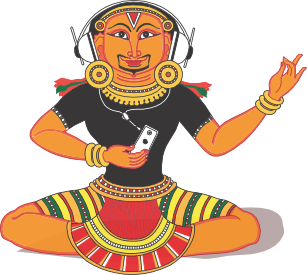
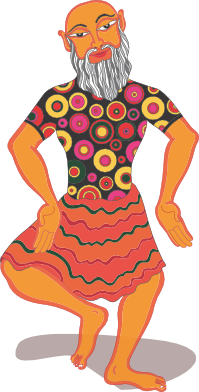
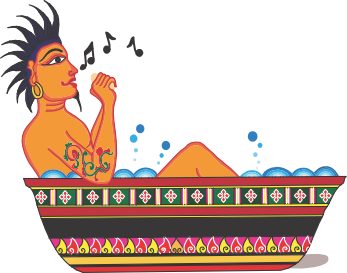
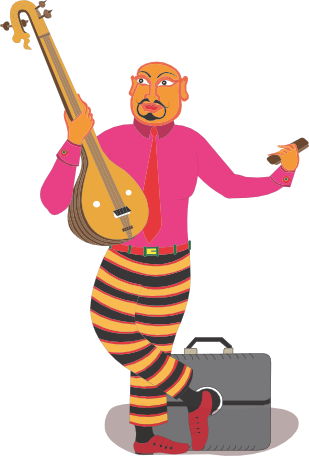
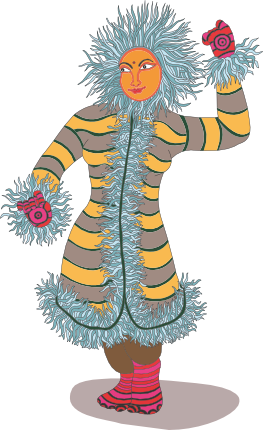
Posted by admin in Dance
on Jul 18th, 2012 | 0 comments
Bharathanātyam
Bharathanātyam is one of the oldest and most popular forms of classical dance in India. It is the dance of both the mind and soul. Its antiquity lies about 3000 years ago with a mythological as well as historical origin. It was originally known as Sadhir-āṭṭam (court dance) and also Dhāsi-āṭṭam (performed by the dhāsis or the servants of God).
The name Bharathanātyam is understood in two ways:
It is the dance (nātyam) that beautifully blends the three elements – ‘Bhā’ – Bhāva (expressions), ‘Rā’ – Rāga (musical melody) and ‘Thā’ Thāḷa (rhythm).
The name Bharatha might have been coined after Bharatha Muni, the great author of the “Nāṭya Śhāsthra”. Much of Indian dance and theatre is codified in this ancient treatise that is believed to have been written by Bharatha (200 BCE–200 CE).
Bharathanātyam is poetry in motion. Bharathanātyam is the classical dance form of South India and embodies music, dance, drama, poetry and mythology to create a complete and highly stylized artistic endeavor which in the end creates Rasa. Rasa is the aesthetic emotion that ultimately transforms the audience. Anything and everything can be conveyed through the rich text of this classical dance form within the aesthetic boundaries and within the codified structure. Bharathanātyam is characterized by strong rhythmic patterns, lyrical expressiveness and sculpture like poses reminiscent of the carvings found on many of the Hindu temples. Bharathanātyam is amongst the finest of our art treasures, the noblest of our inheritances.


According to religious history, the gods and goddesses pleaded with Lord Brahma to create a Vedha which would make it simple for the common man to understand. Thus, Brahma created the fifth Vedha known as the Nāṭya Vedha. It is believed that he took Paṭhya (words) from the Rig Vedha, Abhinaya (gesture) from the Yajur Vedha, Gītham (music and chant) from the Sāma Vedha and Rasa (sentiment and emotional element) from Atharvaṇa Vedha to form the Nāṭya Vedha.
Thereafter, Lord Brahma gave it to sage Bharatha and asked him to popularize it on earth. Following the words of Lord Brahma, sage Bharatha wrote the Nāṭya Śhāsthra (Science of Dramaturgy) a distinguished, comprehensive work on the science and technique of Indian drama, dance and music.
It is also believed that Goddess Pārvathi taught this dance form to Uṣhā, daughter of Bāṇāsura, a demon. Uṣhā, in turn, taught it to the Gopikās of the city Dwārakā, Lord Kriṣhṇa’s birth place, and thus, Bharathanātyam was introduced into the world.
According to Indian mythology, Lord Śhiva is considered the supreme lord of dance. Bharathanātyam is performed by Lord Śhiva and his wife Goddess Pārvathi.
When it is performed by Lord Śhiva, it is known as the Thāṇḍavā and depicts the masculine form of dance incorporating vigorous, brisk movements.
The dance performed by Goddess Pārvathi is known as Lāsya, wherein the movements are gentle, graceful and sensual.
Sculptural evidence particularly in South India, and more especially Thamizh Nāḍu, (Tamilnadu) shows that the basic science and technique of Bharathanātyam was established around 5th Century AD.
In Thamizhnāḍu, classical dance was known as Chinna Méḷam, Sadhir or Kūthu. The evidence of dance can be found in ancient texts such as the Silappadhikāram and the Kūthanūl. The art of Bharathanātyam was patronized by kings and nobles in Thamizhnāḍu. Evidence shows that the great King Rāja Rāja Chōḷa (965-1014 AD) employed 400 danseuses to dance in the temple of Bruhadhīśhwara during the prayer ceremonies. Furthermore, dance sculptures were carved on the outer walls of many temples in South India. The 108 Karaṇas on the outer walls of Chidhambaram temple and the Madhanikā figures of the Bélūr temple are glorious examples of this.
Also, the Nāyaka kings (the commanders of Vijayanagara kings) such as Achuthappa Nāyaka (1592-1614) and his successors Raghunātha Nāyaka and Vijayarāghava Nāyaka (1614-1673) were great lovers and patrons of music and dance. The Marāṭhā kings of Tanjore (1741-1787) Prathāpa Sinha and Thuḷaji were great lovers and patrons of the art form. Mahādhéva Aṇṇāvi and Subbarāya Naṭṭuvanār were great artists in the field of Bharathanātyam. It was Subbarāya Naṭṭuvanār’s sons Chinnayā, Ponnaiyyā, Śhivānandham and Vaḍivélu, otherwise known as the Tanjore Quartet or Thanjai Nālwar, who structured Bharathanātyam to its present day form.
During the reign of the Pallava and Chola Dynasties (4AD -12AD) the art of dancing flourished due to immense patronage. The intimate association of dance with religion as a ritual was established in the temples, and thus the Dhevadhāsi tradition came into form. Dhevadhāsis were female dancers who dedicated their lives to the temples. They were trained in the art of devotional dance and singing and were well-versed in languages, poetry and music. The dance they performed in the temples was known as Dhāsi-Āṭṭam (a precursor to modern day Bharathanātyam). It was also given the name Sadhir, by the Marāṭhā rulers.
The ancient art of Bharathanātyam, earlier performed only before the Lord in the sanctum sanctorum, came out of the precincts of the temples and entered the palaces as the Kings wanted to witness the performances. As it was not customary for kings to mingle with the crowd, arrangements were made for the danseuse to perform in the palaces. Bright and able Dhevadhāsis were no longer respected members of the Indian social community by the end of the 19th century. Gradually, the painful position of Dhevadhāsis disappearing lead married women and girls from respectable families to learn dance.
There was a great wave of reformation in the beginning of the 20th century. Few realized that the authentic lineage of classical dance, while temporarily shamed and driven underground during an unseemly commotion, was being preserved among certain artistically distinguished families. Several of the great teachers (naṭṭuvanārs), carried the knowledge and substance of the art, living neglected lives in remote villages. It was a difficult time for such people, and if not for the courageous and persistent efforts of a handful of supporters, the art form might well have been totally suppressed. Three artists stand out for their efforts in restoring the classical dance to its traditional place of honour in India – Bālasaraswathi, Uday Śhankar and Rukmini Dhévi Aruṇdale.
Compiled by: Aarthi Natarajan & Indira Kadambi




